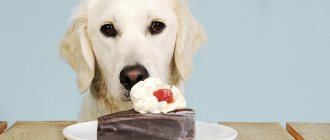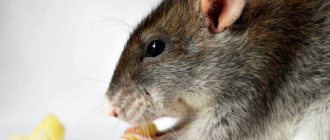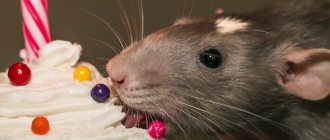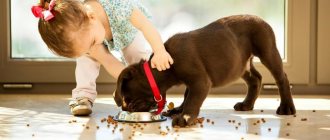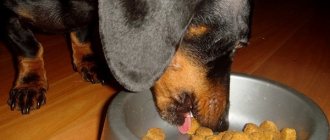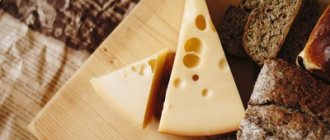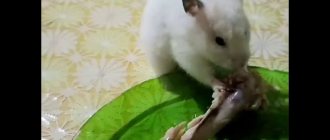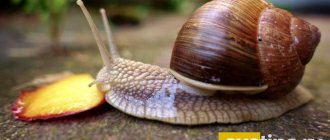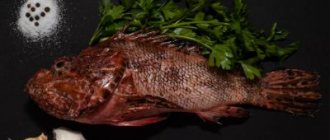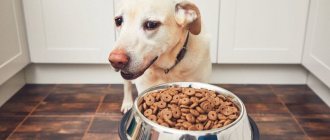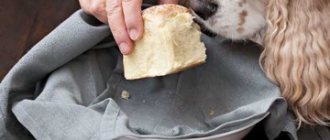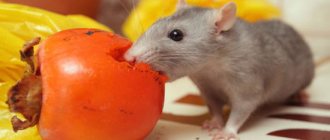If you have chosen a natural way of feeding your beloved four-legged dog, then you should definitely know what you can and cannot feed your dog.
Earlier, when touching on the issues of proper feeding of a dog, I mentioned the names of products that can and should be given to your pet. But today I want to dwell in more detail on which products should be included in the “black list” and try to completely exclude them from the animal’s diet.
Everyone knows that even under the primitive communal system, our distant ancestors ate only what they could catch or collect. And this, as a rule, was meat, fish, eggs, poultry and vegetables. They did not know any excesses in the form of sweets, salt, carbonated drinks and other products that are now produced industrially.
Over the course of many centuries, the human body has developed the ability to assimilate and digest any food. And today we can recycle everything we throw into ourselves without much harm to our health.
But with dogs everything is different. Dogs are the ancestors of wolves. For centuries, wolves have eaten and continue to eat small and large wild and domestic animals. They do not miss the opportunity to eat a clutch of eggs, chicks and even frogs and large insects. Very often, wolves also eat plant foods - various greens, wild berries and fruits. In the steppes they raid watermelon and melon fields in order to satisfy their thirst.
Dogs are domesticated wolves. When taming a wolf, a person gave it everything for food that it was used to eating in the wild. To this day, all experienced dog breeders try to follow this principle of nutrition. Unlike humans, the dog’s body is not accustomed to excesses and has not developed the ability to digest certain foods well.
Of course, eating most of the foods listed below will not immediately harm your pet's health. And nothing bad will happen if your robber steals a piece of a tasty but harmful product from the table. The main thing is that the use of these products is not regular, since the dog’s body, which is unstable to harmful components, may fail over time.
What you should absolutely not feed your pet
The list of prohibited foods for dogs is extensive. Of course, if your pet accidentally swallows a piece of food that is not allowed, nothing bad will happen. But if you feed your dog this way constantly or in large quantities, his health will certainly deteriorate.
The most dangerous food
A number of products lead to serious consequences. The owners know about them, but some stubbornly ignore the prohibitions and continue to give “goodies”. Such foods include:
- Spicy, smoked, marinated, seasoned, salty dishes, sausages. The abundance of salt and fat provokes inflammation of the pancreas, liver, volvulus, obesity, disrupts the water-salt balance, the functioning of the liver, joints, and increases blood pressure.
- Chocolate. Contains theobromine, which leads to poisoning, convulsions, arrhythmia, and in large quantities – death.
- Alcohol. It threatens with intoxication, heart failure, paralysis of the nervous system, and death.
- Sweet. Destroys teeth, leads to diabetes, obesity, and gastrointestinal disorders.
- Yeast dough products. They cause fermentation, lead to painful colic, and occasionally to rupture of the intestinal walls.
- Coffee and tea. Caffeine in drinks is harmful to the heart, nervous system, and disrupts the functioning of the digestive system.
Animal products
Dogs are predators and meat eaters. But not all meat is equally healthy. So, animals cannot be fed:
- Fish, chicken, tubular bones. The fragments damage the digestive tract, can get stuck between the teeth, in the throat, and lead to suffocation.
- Raw river fish. Risk of infection with helminths, injury from small bones.
- Milk. Absorbed only by puppies, it causes diarrhea in adult pets.
- Raw chicken eggs. The enzyme avidin inhibits the synthesis and absorption of vitamin B1, which leads to skin and coat diseases. Salmonella infection is also possible.
Plant food
Vegetables, fruits, berries, and cereals supply the pets’ body with vitamins; without them, normal functioning of the digestive organs is impossible. However, a number of plant products are dangerous for dogs.
Prohibited fruits and vegetables:
- Peaches, persimmons, plums. Lead to intestinal obstruction.
- Grapes, raisins, currants. Causes kidney failure. Although some dogs, regardless of breed, tolerate berries well, it’s not worth the risk.
- Citrus fruits, kiwi, pineapples. Lead to allergies and stomach inflammation.
- Avocado. The poisonous element persin leads to intoxication.
- Raw cabbage. Provokes increased gas formation.
- Potatoes – raw, boiled, fried. Contains a lot of easily digestible carbohydrates, starch and solanine, which are harmful to the pet's body.
- Broccoli. Toxic in large quantities due to isocyanate.
- Onion and garlic. The presence of thiosulfates provokes anemia.
- Fruit and pomegranate seeds. Causes intestinal obstruction and contains cyanide, which is poisonous to dogs.
Harmful grains, greens and more:
- Legumes. They are poorly digested and absorbed, leading to flatulence.
- Corn. An allergen that causes stomach upset, damages teeth, and increases blood sugar levels.
- Sorrel and rhubarb. Due to oxalates, the functioning of the urinary system is disrupted.
- Spinach. Contains a toxic substance, oxalate, which is harmful in large quantities.
- Hop. Provokes shortness of breath, convulsions, fever and increased heart rate.
- Porridges made from corn, wheat, semolina, pearl barley. They are poorly absorbed and digested, causing bloating.
- Mushrooms. There is a high probability of poisoning; they contain chitin, which is harmful to the liver and pancreas.
- Nuts. They are not absorbed by canines and disrupt the functioning of the gastrointestinal tract.
The list of foods that should not be given to dogs will be useful not only for adherents of natural food, but also for those who feed their dogs industrial food. If the composition contains one of the above ingredients, you should not purchase the product.
It's just like people
Chocolate - theobromine contained in it causes bloating, vomiting, diarrhea, arrhythmia, convulsions, and in large quantities can be fatal.
Dogs love chocolate very much and, if the owner is irresponsible, can find and eat the treat on their own. And to remove this toxin from the body, you will need a lot of money and time spent on repeated trips to the veterinarian.
- Alcohol leads to nervous convulsions, heart failure and death.
- Baking with yeast leads to fermentation in the intestines, resulting in abundant gas formation, which, in addition to an unpleasant odor, causes pain in the animal.
If a dog eats raw dough, it can cause intestinal volvulus, which can be fatal.
Tea and coffee - the caffeine they contain leads to rapid heartbeat, aggressive behavior, and increased blood pressure.
Which of the “forbidden fruits” can sometimes be given to dogs?
It’s not always possible for owners to withstand the dog’s pitiful gaze and not pamper him with something tasty. The good news is that you can give up. In small quantities, the dog is allowed to eat:
- Pork. It is oily and may contain the plague virus and parasite eggs. But it can be given occasionally after careful heat treatment.
- Bread and flour products. Lead to excess weight, constipation, flatulence. You can pamper your pet occasionally. It is advisable to treat your dog not with buns and cookies, but with crackers and bagels.
- Celery. Contains many useful elements and vitamins. But the vegetable is coarse and fibrous, and dogs do not know how to chew - they only chop up the food and swallow it in pieces. If you want to give your dog celery, you need to grind it in a meat grinder or blender - this way the greens will easily pass through the digestive tract and be absorbed by the body.
- Cheese. Dogs love him. But the product contains lactose and fats, which are poorly digestible. Therefore, you can give low-fat varieties in small portions - as a treat or reward.
- Boiled and stewed cabbage. Heat-treated vegetables are better absorbed than raw vegetables. But the dog should be fed it carefully and occasionally.
- Peanuts and peanut butter. The only legume that is recommended for dogs in moderation. The kernels contain niacin, vegetable fats, vitamins E and group B.
- Dried fruits. Dried apricots and prunes are an excellent treat during training.
- Ice cream. Yes, harmful sweetness. But you can treat your dog once every 1-2 months. You need to take a clean filling without fillers or dyes. It is advisable to melt the dessert so that your pet does not catch a cold.
Basic principles for adult pets
The nutrition of puppies and adult dogs is different, so as your pet develops, it is necessary to gradually switch to new feeding regimens that are appropriate for the dog's age. For owners of pets older than 1-2 years, there are certain rules. Basic feeding requirements for adult dogs:
- What works for people is often harmful for dogs. You cannot feed human food from the table, treat them with harmful delicacies, or let them try drinks.
- Dogs benefit from monotony. If you want to pamper your pet, you can sometimes give special treats, but there is no need to come up with a variety of dishes every day. It is better to determine the most suitable products (with natural feeding) or the optimal manufacturer of ready-made food and stick to a monotonous diet throughout life.
- Do not mix branded food with natural food. Change and adjust the diet only if necessary.
- Not only the quality of the products is important, but also the correct feeding mode. Receiving food at the same usual time helps the proper production of digestive juices, promotes comfortable digestion, and has a positive effect on metabolism.
- The serving size of the food should be appropriate for the size of the dog. You should not overfeed your pet, even if he plaintively begs for more, having previously eaten a full portion. It is also harmful to keep your dog hungry.
- Be sure to take into account the physiological state of the pet, its age, and lifestyle.
- When feeding natural products, it is necessary to periodically introduce mineral and vitamin supplements into the diet. It is important to combine and prepare products correctly.
- You need to monitor the temperature of the feed. Since hot or cold foods can damage your pet's digestive tract, you need to bring the temperature of the food closer to 30 - 35 degrees, which is slightly lower than the animals' normal body temperature.
A caring owner should also pay attention to how the pet eats: what kind of appetite it is, whether it asks for more or, on the contrary, leaves some of the food, is it difficult to swallow. It is useful to evaluate how a dog approaches a bowl of food and what it does after eating in order to assess the pet’s well-being as informatively as possible. You need to pay attention to any changes in order to understand how the dog feels and whether it needs help and, accordingly, dietary adjustments.
For your information! It is necessary to monitor the cleanliness of water and food bowls. Wash dishes thoroughly regularly without chemical cleaning agents. The food bowl must be put away in the cupboard on time.
There must be fresh water freely available and in sufficient quantity so that the pet can drink at any time. The water needs to be changed daily. It is also useful to monitor how your dog drinks - whether he is thirsty or, conversely, whether the pet drinks enough water. If necessary, this data can tell a lot.
General rules for healthy eating
If the owner decides to feed the dog natural food, he should know several key principles:
- They give either dry food or products of natural origin. As a last resort, these two types are divided into different feedings: for example, natural feeding is done in the morning, and dry feeding is done in the evening.
- Food should be slightly warm. Dogs grab and swallow food without chewing. She will not have time to heat up or cool down in her mouth.
- All products must be fresh. Missing leftovers cannot be fed. Rotten meat is harmful not only to people.
- In percentage terms, the dog’s diet looks like this: meat, offal and fish - 60%, cereals - 10 - 15%, vegetables and herbs - 10 - 15%, fermented milk and eggs - 20 - 25%, other - less than 5%.
- You cannot feed your dog from the table. Foods familiar to people are not suitable for pets.
- Meat and offal must undergo heat treatment. They are placed in the freezer for 4 - 5 days. Then defrost and pour boiling water over it.
- Any fish needs to be boiled. Some varieties contain the enzyme thiaminase, which causes vitamin B1 deficiency. Others are the trimethylamine oxide enzyme, which interferes with iron absorption and leads to anemia. Elements are destroyed when exposed to high temperatures.
- Each serving of food should contain meat, grains and vegetables at the same time. Fermented milk products are given separately - before or after a couple of hours from the main feeding.
The severity is due to the structure of the canine digestive tract. They are not able to assimilate and digest food to which the human body has adapted for centuries.
If the choice falls on drying, you need to purchase only one specially designed for dogs.
Dogs should not be fed cat food - it contains more fat, meat, less fiber and grains (they are not added to holistic-class lines at all).
There is no need to panic if your dog steals a piece of sausage, biscuit or fried meat - it is not fatal. The main thing is that such eating does not become a habit. It is also worth making sure that the dog does not pick up garbage on the street and is not treated to forbidden delicacies by guests and compassionate strangers.
Summarizing
Many people are confident that dogs can decide for themselves how to eat and will never beg for or eat harmful and dangerous foods. It is not true. Animals cannot assess the degree to which a particular substance is needed in their body. If a dish or product has an attractive smell, the pet will try to get food in any way.
From the first days when the puppy appeared in the house, owners must strictly prohibit him from stealing from the table
Also, the owner of the dog and his family members must agree that no one will feed the animal from the table or from hand, out of pity for the “sad hungry eyes,” offering the pet forbidden food. Without handouts, the dog will feel healthy and live a long life, and even a small piece of chocolate can bring great grief to a family that has unexpectedly lost a beloved dog.
What is recommended to feed your pet?
The list of approved foods that are safe to give to dogs includes:
- meat (chicken, beef, lamb, pork), but always boiled. Raw meat may contain parasites or pathogens. You can use ground beef or chicken. In this case, the lamb must be given carefully. It is allowed to feed offal: neck, lungs, limbs (for example, chicken feet), as well as liver;
- fish. You just need to know what kind of fish dogs can eat. It is allowed to feed representatives of the salmon family (for example, pink salmon, hake, river trout, etc.). Other types should be added to the diet carefully and only after 20 minutes of cooking. Some varieties of fish contain enzymes in the head and internal organs (for example, thiaminase), which destroy vitamins or provoke the development of illnesses. This is why not all types of fish can be given to domestic dogs;
- cereals (for example, rice);
- vegetables: carrots, lettuce, spinach, pumpkin;
- fruits and berries: banana, pear, melon;
- peanut butter.
These products can be given to representatives of any breed. But there is food that is included in the diet in moderation.
Rules for sterilized pets
Feeding pregnant, whelping, and postpartum dogs differs from normal feeding for adult dogs. You can read more in a special article.
If you do not intend to breed and prefer to sterilize your dog, you will also have to make some changes to its diet.
In sterile pets, many processes in the body change. For example, hormonal levels shift, and the risk of gaining excess weight increases due to some changes in metabolism. Such pets fall into the category of increased risk of developing urolithiasis (urolithiasis).
Of course, this does not mean that neutered dogs automatically have poorer health. On the contrary, this operation reduces the risk of cancer and inflammatory diseases of the genital organs. According to statistics, after sterilization, pets live on average longer than non-neutered ones. However, in any case, after such an operation, the dog needs to change its care. In particular, your diet should be reviewed.
Many industrial food manufacturers offer a line of products for neutered females and males. If you give preference to this food, you will not need to supplement the diet. When the owner gives his pet homemade food, it is important to exclude salt and fish, sometimes reduce the amount of fatty components and monitor the balance of the protein components of the food. Sometimes certain types of protein are excluded. The best solution would be to consult a veterinarian to choose an individual diet based on the characteristics of a particular dog’s body.
What to give in moderation
There is a whole group of foods that dogs are allowed to eat, but in moderation. This group includes:
- low-fat cheese;
- milk. Over time, adult pets lose the ability to digest milk. Therefore, it is replaced with fermented milk products (yogurt, low-fat cottage cheese, kefir);
- pasta;
- peeled seeds (sunflower and pumpkin);
- fruits and berries: apples, blueberries, strawberries, persimmons;
- bread. Due to the high content of carbohydrates in large quantities, it provokes digestive disorders;
- eggs (chicken, quail). You can also add eggshells to your diet;
- walnuts and peanuts;
- cabbage. In large quantities it can cause flatulence.
If you are unsure whether you can feed a particular food to your dog, it is best not to give it a treat until you are sure about it. Otherwise, you can cause serious harm to your pet's health.
Features of representatives of different breeds
Dogs of different breeds are very diverse, and, although they belong to the same species of animal, they have their own morphological characteristics. For example, representatives of small breeds, such as Mittelspitz, Italian lapdog, Bedlington terrier, consume more energy per day than large dogs in relation to their own weight. However, in total, large dogs still need to consume more calories per day due to their larger body weight.
Toy dogs are prone to oral diseases, particularly dental problems. Therefore, food for them should be more fragile, soft and pliable. However, do not forget about the prevention of tartar - sometimes you need to pamper your dog with hard treats.
It is important to take into account the metabolic rate of dogs of different breeds. Due to the faster metabolism of small breeds, such as the Prague Rat, dogs need to be fed at least 2 times a day; the best option is three meals a day, with the bulk of the daily portion given at lunch. Many dwarf dogs are prone to obesity, so these pets can be fed up to 4 times a day in small portions.
Large dogs are fed 2 times a day, the main meal of the day is dinner. It is also permissible to feed only 1 time in the evening. The size of the pieces of food must correspond to the size of the pet, so that the dog does not choke and chews the food for a long time.
Canned food for dogs
Strictly prohibited products
Let's now figure out what absolutely cannot be given to dogs. This list will be slightly longer than in the case of permitted products.
You cannot feed your four-legged friend the following types of food:
- grapes and raisins. Signs of poisoning will appear within a few hours;
- seasonings and spices. They cause thirst, and can also provoke intestinal volvulus and dilation of the stomach. Spices negatively affect the animal’s sense of smell;
- smoked meats, pickles and spicy dishes. They contain a lot of fat and salt. They can provoke the development of inflammation of the pancreas;
- raw fish and bird bones. Such elements easily get stuck in the throat and can cause choking, bleeding and inflammation. In addition, helminths and other parasites enter the dog’s body with raw bones;
- raw meat. It is a source of parasites and infectious diseases. It is allowed to give only meat that has been well frozen (stayed in the freezer for 4–5 days). Before your pet eats such meat, the product is cut into small pieces and doused with boiling water. But even such actions do not guarantee complete safety;
- fatty meat scraps. It can provoke obesity and also contributes to the development of pancreatitis. You can feed the dog only pulp, as well as fragments with a small content of cartilage, veins and layers;
- potato. Once eaten, potatoes can cause diarrhea;
- chicken raw eggs. Through them, your pet can contract the pathogen salmonellosis. This product should only be given boiled.
It was already said a little above that dogs are not allowed to feed all types of fish. It is strictly forbidden to give them river fish, which consists of a large number of bones. Also, river species are often affected by helminths and other parasites.
It is not recommended to feed dogs fruits that contain seeds. Before feeding, they must be pitted. If apricots, cherries or plums enter the animal's body, they can cause blockage of the digestive tract or poisoning, since the pits contain poison (cyanide).
You should not feed your pets sweets, candies, chocolate or give them coffee beans. For four-legged pets, these products are real poison. They provoke serious poisoning. Moreover, a fatal outcome is quite possible. Death occurs when eating sweets at a dose of 0.3 g per 1 kg of animal weight.
Can dogs eat raw food? Myth or reality?
A number of European researchers in the field of cynology (Sweden) have spoken in recent years about the dangers of many raw foods. Almost all natural feeding. Especially raw meat products. Moreover, this is increasingly spreading both in Europe and beyond. This is motivated by the results of a number of studies. Samples taken from frozen meat from 10 different European producers were examined. Thus, in the studied samples of raw meat, bacteria were found, possibly pathogenic and with a high content of them. Enterobacteriaceae were found in all samples above the permissible threshold. Some samples contained salmonella or Campilobacter bacteria.
From this the following conclusions were drawn:
- In families with children and teenagers, dogs should be switched exclusively to dry food. Since children are susceptible to infection due to fragile immunity.
- Meat for feeding dogs must be thoroughly washed and then frozen before use. Defrosting should occur at a temperature no higher than 10°C. To process this product, use separate dishes and knives, which must then be thoroughly washed. Using detergents.
- Dogs should not be fed this food if they are receiving antibiotic therapy. It seems like this could lead to the emergence of antibiotic-resistant strains.
It should be noted that in the last couple of decades in Europe, very, very, to put it mildly, ridiculous newfangled trends are sometimes born. In cynology and veterinary medicine as well. Sometimes to the point of real absurdity. Therefore, all their fabrications should be taken with great caution.
Regarding this issue. The first conclusion frankly smacks of an attempt to advertise dry food as opposed to natural food. After all, the proportion of dog owners with children in families is very large. The second is quite fair, you cannot give meat to dogs without proper processing, although everyone has known this for a long time. But why are ordinary normal hygienic measures a revelation for Europeans? In principle, this is also not news - historically, the reputation of Europe for centuries not knowing what cleanliness is is the subject of jokes. Especially considering their super savings in water consumption. Well, the third conclusion - well, this is generally just bullshit, there’s no other way to put it.
conclusions
The dog's health depends on proper feeding. The products that your pet eats must be of high quality and fresh, and must be combined correctly. It is also important how regularly the dog eats, and whether he walks on a full stomach.
If feeding standards are violated, sooner or later problems with the pet’s health will arise. A careless attitude to nutrition can result in both fairly harmless allergic reactions - dandruff, local baldness, and life-threatening problems with the gastrointestinal tract - gastritis, colitis, gastric torsions and others.
In order for your pet to live a healthy and fulfilling life, it is necessary to understand the importance of a balanced, regular diet and adhere to the norms and rules of feeding dogs, taking into account the breed, lifestyle and physiological state of the pet.
